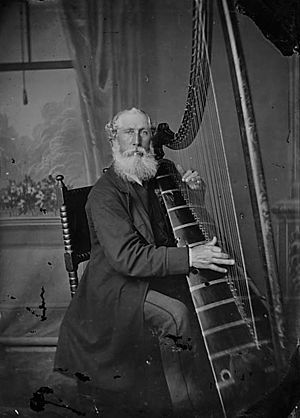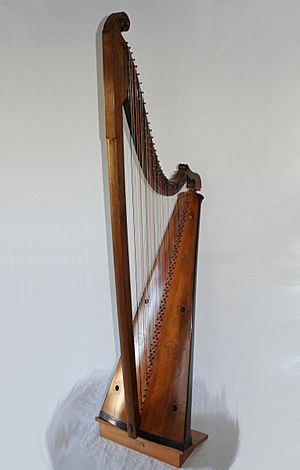Triple harp facts for kids
The triple harp is a special type of harp. Unlike most harps with one row of strings, it has three rows! One common kind is the Welsh triple harp. In Welsh, it's called telyn deires. Today, it's mainly played by people who love traditional Welsh folk music.
Contents
Where Did the Triple Harp Come From?
The triple harp first appeared in Italy in the 1500s. Back then, musicians wanted to play more complex songs. These songs needed extra notes, called "sharps" and "flats."
To do this, harp makers added a second row of strings. This new row had all the sharp and flat notes. Harps with two rows were called arpa doppia, meaning "double harp." They were the first harps that could play all the notes.
Later, a third row of strings was added. This created the arpa tripla, or "triple harp." Double and triple harps were very popular in Italy, Spain, and France. They were used for solo music and to support other instruments.
One very famous Italian triple harp still exists today. It's called the Barberini harp. This beautiful instrument was made between 1605 and 1620. It was built for the powerful Barberini family. You can even see it in a painting by Giovanni Lanfranco called Venus plays the harp.
The Welsh Triple Harp
How the Triple Harp Came to Wales
The triple harp arrived in Britain in the early 1600s. In 1629, a French harp player named Jean le Flelle came to England. He became the official harpist for King Charles I. Flelle played an Italian triple harp with strings made from animal gut.
Welsh harpists living in London quickly started using the triple harp. It became so popular that by the 1700s, it was known as the "Welsh harp." Charles Evans was the first Welsh triple harpist we know of. He became the king's harpist in 1660. His official title was 'His Majesty's harper for the Italian harp'.
What a Welsh Triple Harp Looks Like

A harpist named John Parry (Bardd Alaw) described the Welsh triple harp in 1839. He said it usually has about five octaves of notes.
- The main row of strings is on the right side. This is where the player's right hand plays the low notes. It has about 37 strings.
- The middle row has 34 strings. These strings create the sharp and flat notes.
- The left-hand row has 27 strings. This row is for the higher notes.
The two outside rows are tuned the same. They play the "natural" notes, like the white keys on a piano. If a song needs a different key, the player adjusts the outside strings. For example, to change from C to G, all the F notes are made sharp.
If a player needs a sharp or flat note that isn't in the main tuning, they use the middle row. They reach a finger between the outer strings to find the right note. People tried to invent ways to avoid re-tuning the harp often. But these attempts didn't work well. This problem was finally solved with the invention of the pedal harp.
Making Welsh Harps Today
For about 60 years, no one in Wales was making harps. Then, a very skilled craftsman named John Weston Thomas brought the art back. He made Celtic, chromatic, and triple harps until he passed away in 1992. A special prize was created in his memory. It encourages people to compete in traditional folk harp playing.
John Weston Thomas taught his skills to three students. One of them, Alun Thomas, is his son. Alun still makes triple and Celtic harps in his workshop today. Another student, Allan Shiers, also continues the tradition. He founded Teifi Harps in Llandysul, Wales.
How to Play the Welsh Triple Harp
One important way to play the Welsh triple harp is called "unisons." This is also known as "split doubling." To create this sound, the player plays the same note on both outside rows. They use their right and left hands very quickly, one after the other. So, if the music is C-D-F-E, the player would play CC-DD-FF-EE.
For a long time, Welsh harpists played with the harp on their left shoulder. This was different from how harpists played in other parts of Europe.
Modern Triple Harp Players
After the early 1900s, triple harps were almost forgotten in Wales. Most players started using the modern pedal harp. But one person, Nansi Richards (1888–1979), helped keep the instrument alive. She learned to play from Gypsy harpists in the Bala area.
Nansi Richards taught the brothers Dafydd and Gwyndaf Roberts. These brothers later started the famous Welsh folk group, Ar Log. Both brothers are great triple harpists. In Ar Log, Dafydd usually played the triple harp, while Gwyndaf played other types of harps.
Today, Robin Huw Bowen is a leading player of the triple harp. He was inspired by Ar Log's music and switched to the triple harp. Llio Rhydderch, another student of Nansi Richards, focuses on teaching new young harpists. A group of triple harp players called Rhes Ganol (Middle Row) was formed in 2000.
Many other talented people play the triple harp today. Some include Rhiain Bebb, Huw Roberts, and Sioned Webb. A few classical harpists in Wales also play it, like Angharad Evans and Elinor Bennett.
Some players from outside Wales also perform on the triple harp. They help show that the instrument can play more than just Welsh music. These players include Maria Christina Cleary and Cheryl Ann Fulton.
Even modern composers are interested in the triple harp. For example, Richard Barrett included it in one of his large musical works.



